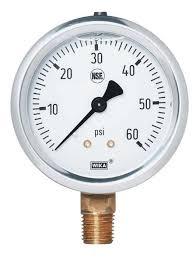The Critical Role of Certified Pressure Gauges in Industrial Safety

In high-stakes industrial environments, precision matters. From oil refineries to manufacturing plants, even a small deviation in pressure can lead to major equipment failure—or worse, put lives at risk. That's where certified pressure gauges play a vital role.
These aren't your average gauges. They're tools backed by industry standards, tested for accuracy, and trusted in environments where safety and performance cannot be left to chance.
Why Certification Matters
Not all pressure gauges are created equal. Certification ensures that the instrument has been calibrated to meet strict standards, often set by organizations like the National Institute of Standards and Technology (NIST) or ISO.
Here’s what that means in practice:
-
Accuracy within tight tolerances
-
Reliable performance under harsh conditions
-
Traceable calibration records
-
Peace of mind for compliance audits
In sectors like energy, pharmaceuticals, or water treatment—where a single fault can halt operations or cause environmental damage—certification is not just a box to tick. It's a safeguard.
A Real-World Scenario: Avoiding Downtime
Imagine you're managing a remote team in charge of maintaining a natural gas processing unit. The system is showing a pressure drop. If you’re using uncertified equipment, it might be a calibration issue—or it might be a leak.
You call in technicians, halt part of the operation, and run diagnostics. After hours of work, you realize the gauge was inaccurate. That mistake cost you time, resources, and trust from the stakeholders.
Now flip the scenario. A certified pressure gauge, properly installed and logged, shows accurate readings from the start. The team quickly isolates the real issue, fixes it, and avoids a shutdown.
That’s the difference certification can make.
Where Certified Gauges Are Essential
Some areas where certified pressure gauges are a must:
-
Pharmaceutical production – where sterility and pressure control are legally regulated
-
Aerospace – where minute variances in pressure can impact safety
-
Water treatment facilities – where consistent pressure is required for safe distribution
-
Fire protection systems – where under- or over-pressurization can cause malfunction
Understanding the NFPA Hydrant Color Code
One area where pressure readings are crucial—but often overlooked—is in fire hydrant systems. That’s where the NFPA hydrant color code comes into play.
The NFPA (National Fire Protection Association) uses a color-coding system to communicate the available flow rate of a hydrant. This helps firefighters know, at a glance, how much water pressure they can rely on during an emergency.
Here’s a simple breakdown:
| Color | Flow Rate (GPM) | Classification |
|---|---|---|
| Red | Below 500 | Class C – Poor |
| Orange | 500–999 | Class B – Moderate |
| Green | 1000–1499 | Class A – Good |
| Blue | 1500 or more | Class AA – Excellent |
Using certified pressure gauges to test hydrant systems ensures that the color-coded classification reflects reality. That’s critical when fire response teams need every second and every gallon to count.
You can learn more about NFPA standards from their official website here.
Choosing the Right Gauge
When you're selecting a certified pressure gauge, there are a few key factors to consider:
-
Application Type: Is it for gas, liquid, or steam?
-
Range: What pressure range do you need it to measure?
-
Environment: Will it be exposed to extreme temperatures or corrosive materials?
-
Mounting Style: Panel, surface, or remote mounting?
And of course, make sure it's from a reputable source. At NFPA Hydrant Color Code, we offer pressure gauges that are tested, certified, and compliant with current fire safety and industrial standards. You can explore our certified equipment and support documentation here.
Certification Doesn’t End With the Label
It’s not enough to buy a certified gauge and install it. Maintenance matters just as much.
Here are some tips:
-
Calibrate regularly – every 6 to 12 months depending on usage
-
Inspect visually – look for any signs of wear, corrosion, or damage
-
Record and log – keep traceable records for compliance and auditing
-
Train your team – ensure remote workers know how to read and respond to pressure data accurately
For remote teams or startups managing facilities across locations, digital monitoring tools paired with certified gauges can create a real-time feedback loop—allowing for faster responses and better safety oversight.
Conclusion: A Small Tool With Big Impact
Certified pressure gauges may seem like a small part of the larger industrial ecosystem, but their impact is anything but small. In fire safety, industrial operations, and remote infrastructure management, they provide the kind of dependable accuracy that systems—and lives—depend on.
Don’t let something as basic as a pressure reading be the weakest link in your operation.
- Art
- Causes
- Crafts
- Dance
- Drinks
- Film
- Fitness
- Food
- Giochi
- Gardening
- Health
- Home
- Literature
- Music
- Networking
- Altre informazioni
- Party
- Religion
- Shopping
- Sports
- Theater
- Wellness


